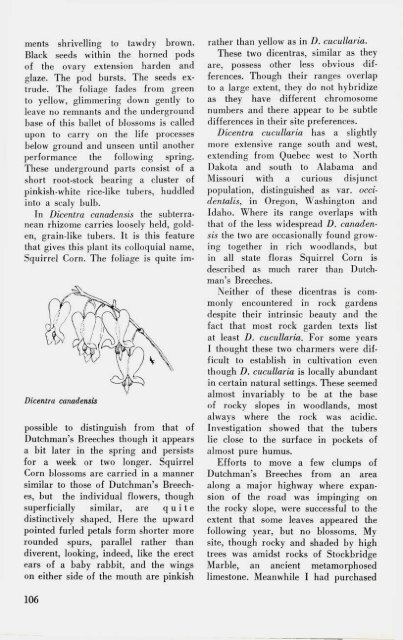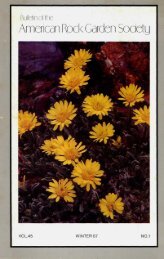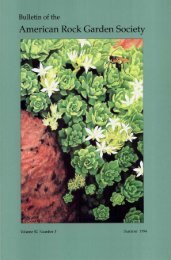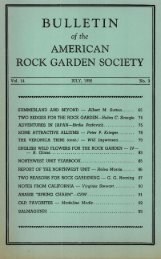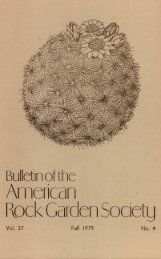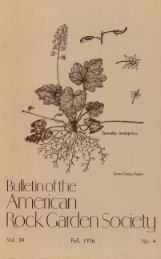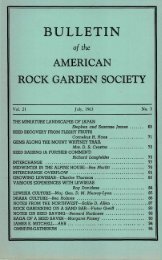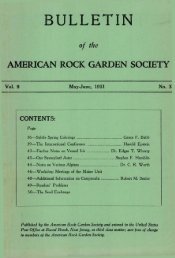Bulletin - Summer 1979 - North American Rock Garden Society
Bulletin - Summer 1979 - North American Rock Garden Society
Bulletin - Summer 1979 - North American Rock Garden Society
You also want an ePaper? Increase the reach of your titles
YUMPU automatically turns print PDFs into web optimized ePapers that Google loves.
ments shrivelling to tawdry brown.Black seeds within the horned podsof the ovary extension harden andglaze. The pod bursts. The seeds extrude.The foliage fades from greento yellow, glimmering down gently toleave no remnants and the undergroundbase of this ballet of blossoms is calledupon to carry on the life processesbelow ground and unseen until anotherperformance the following spring.These underground parts consist of ashort root-stock bearing a cluster ofpinkish-white rice-like tubers, huddledinto a scaly bulb.In Dicentra canadensis the subterraneanrhizome carries loosely held, golden,grain-like tubers. It is this featurethat gives this plant its colloquial name,Squirrel Corn. The foliage is quite im-Dicentra canadensispossible to distinguish from that ofDutchman's Breeches though it appearsa bit later in the spring and persistsfor a week or two longer. SquirrelCorn blossoms are carried in a mannersimilar to those of Dutchman's Breeches,but the individual flowers, thoughsuperficially similar, are quitedistinctively shaped. Here the upwardpointed furled petals form shorter morerounded spurs, parallel rather thandiverent, looking, indeed, like the erectears of a baby rabbit, and the wingson either side of the mouth are pinkishrather than yellow as in D. cucullaria.These two dicentras, similar as theyare, possess other less obvious differences.Though their ranges overlapto a large extent, they do not hybridizeas they have different chromosomenumbers and there appear to be subtledifferences in their site preferences.Dicentra cucullaria has a slightlymore extensive range south and west,extending from Quebec west to <strong>North</strong>Dakota and south to Alabama andMissouri with a curious disjunctpopulation, distinguished as var. occidentalis,in Oregon, Washington andIdaho. Where its range overlaps withthat of the less widespread D. canadensisthe two are occasionally found growingtogether in rich woodlands, butin all state floras Squirrel Corn isdescribed as much rarer than Dutchman'sBreeches.Neither of these dicentras is commonlyencountered in rock gardensdespite their intrinsic beauty and thefact that most rock garden texts listat least D. cucullaria. For some yearsI thought these two charmers were difficultto establish in cultivation eventhough D. cucullaria is locally abundantin certain natural settings. These seemedalmost invariably to be at the baseof rocky slopes in woodlands, mostalways where the rock was acidic.Investigation showed that the tuberslie close to the surface in pockets ofalmost pure humus.Efforts to move a few clumps ofDutchman's Breeches from an areaalong a major highway where expansionof the road was impinging onthe rocky slope, were successful to theextent that some leaves appeared thefollowing year, but no blossoms. Mysite, though rocky and shaded by hightrees was amidst rocks of StockbridgeMarble, an ancient metamorphosedlimestone. Meanwhile I had purchased106


